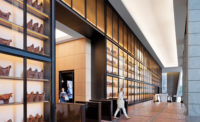No one likes the hole in the west side of Manhattan—the black accordion of train tracks between 30th and 33rd Streets, west of 10th Avenue. But the 26-acre property has confounded developers for decades, mostly because the expense of building a platform over the railyards means that only a cluster of very tall buildings, with very large floorplates, can provide the kind of return investors hope for. But in December the Related Companies, headed by Stephen M. Ross, broke ground on the eastern half of the Hudson Yards development, one of the largest construction project in New York City history, with nearly 13 million square feet of office, residential, and retail space. Ross hopes Hudson Yards will compete, on a global scale, with financial districts like Shanghai’s Pudong and London’s Canary Wharf. But that begs the question: Will it become a windswept no-man’s-land of mega-buildings, or—as its designers hope—a new Manhattan neighborhood worth hanging out in?
The answer will depend in part on the work of Manhattan architect Bill Pedersen, whose firm, Kohn Pedersen Fox (KPF), is master-planning the entire Hudson Yards development (as well as designing several of its largest buildings). Pedersen says he has focused his attention on the High Line, the elevated park that has transformed the lower west side of Manhattan and, when its third phase is completed, will loop around the Hudson Yards site. Tearing down that portion of the High Line, which is something real estate developers once vowed to do, is now out of the question, according to Pedersen. In fact, the first building to be built at Hudson Yards will overhang the High Line, bringing the park and a skyscraper together in what the architect hopes will be a comfortable alliance. From there, the High Line will run alongside the Culture Shed, a vast telescoping gallery and performance space, and the Culture Tower, a condo building with a distinctive four-leaf clover shape, both designed by Diller Scofidio + Renfro with Rockwell Group. Then it turns north to meet another skyscraper, this one by David Childs of Skidmore, Owings and Merrill. Much of the development is still being designed; meanwhile an exhibition and related programs at the Center for Architecture in New York, Design in the Heart of New York (through June 30), is taking a close look at how Hudson Yards will impact the city.
In his office overlooking Bryant Park, Pedersen showed RECORD the latest plans for Hudson Yards.
Will Hudson Yards feel like a real Manhattan neighborhood?
The degree to which it connects and links into the city has been our total preoccupation. We want these buildings to reflect New York and not Hong Kong or Shanghai. And for that to happen, they have to respond to specific local conditions. Luckily, we have the High Line. If this were happening without the High Line, if we were stranded on the West Side of Manhattan, it would be unaccomplishable.
How does the first building, the 895-foot tower at the northwest corner of 30th Street and 10th Avenue, respond to local conditions?
It started out as a spec office building. When Coach came in, as lead tenant, we were given more direction. Coach was founded two blocks away, and they consider this to be their native soil. They had input on both the materials and the configuration of the building. There’s a unique wall type—shingled glass—that is specific to this building. [Coach CEO] Reed Krakoff immediately took to that idea—he felt the shingling was very American. They also wanted a campus. We responded by pulling a piece of the tower out from the building’s mass, and forming an atrium, which looks directly south down the axis of the High Line, and becomes the High Line’s northern terminus. Meanwhile, the lobby portion of the building establishes a scale relationship with the Culture Shed. They’re gesturing to each other across the square.
Have you been working with the architects of the Culture Shed and Culture Tower?
We’re in close communication. We collaborated with Diller Scofidio + Renfro in turning the Culture Shed 90 degrees from its original orientation, so that as you approach Hudson Yards from the south, you get the elegance of its profile and it becomes a gateway to the central plaza.
What will the central plaza be like?
In Columbus Circle [where Steve Ross developed the Time Warner Center] there was already a center of gravity. Here everything depends on what he puts in the plaza. This is his legacy. So he is looking all over the world for the best artists. The idea is to create pieces of a significant scale, to mediate between the size of the buildings and the size of the individual.
What is the impact of having the railyards below?
We have tremendous vent requirements. The vents have to be high, at least 30 feet. And there are nine of them. But they offer points of departure, through sculptural or landscape interventions.
What does this project mean to you and KPF?
It’s fair to say that for the 38 years that we’ve been practicing, and doing many large commercial towers, we’ve been working to make that building type a better participant in the city. And this is the final exam.




















Post a comment to this article
Report Abusive Comment